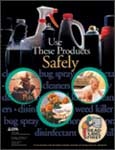Pesticides
When it comes to ridding your home of unwanted pests, it's a case of "pick your poison". While some people fear common pests like ants, cockroaches and rodents, others worry more about the chemical pesticides used to kill or repel these creatures.
Those worries not withstanding, it's estimated that more than three-quarters of U.S. households use pesticides of some type, whether it's to rid the kitchen of ants, the garden of bothersome weeds, or their pets of fleas and ticks.
Despite their common household use, surprisingly little is known about the hazards associated with this type of exposure. Most medical research has focused on people, such as agricultural workers, who are regularly exposed to very large amounts of pesticides. In these individuals, pesticides have a wide range of health effects-from nervous system damage to an increased risk of some cancers.
Until pesticides are developed that are conclusively demonstrated to be safe, your best protection is to minimize your exposure by using them only when absolutely necessary. While that approach may sound obvious, many people use pesticides even when there is no significant problem with pests.
The best approach is to prevent pest problems from developing. Install screens on all the doors and windows and seal any openings in the floors or walls to keep pests (like bees, flies and rodents) from entering your home. Eliminate access to food and water, without which pests cannot survive. Storing food in tightly sealed glass or plastic containers, for example, will go a long way in the battle against ants.
In the garden, select plants known to resist disease and insects, and mulch regularly. If pests do become a problem in your home, use alternative means of controlling them whenever possible. Mouse traps can be set; a 'swatter' can be used to kill flies, bees and wasps; and weeds in the garden can be hand-picked. In some cases, insects can even be used for pest control purposes. Releasing ladybugs in the garden, for example, helps keep aphids under control.
If you opt to use a pesticide, select the least dangerous product possible. Read the label carefully for clues to the product's toxicity. The words "danger-poison" signify that the product contains chemicals that can be highly poisonous (these products are typically only available to certified pesticide applicators). The word "danger" is used to identify products that are poisonous or corrosive. "Warning" means that the product is considered moderately hazardous. And "caution" indicates that the product is considered least hazardous.
Once you select a pesticide, use it only as directed on the product label. The label is the law: It is a federal violation to use any pesticide in a manner inconsistent with its labeling. Never apply more pesticide than recommended by the product manufacturer.
Also, some pesticide labels will recommend wearing protective clothing, such as nonabsorbent gloves, rubber footwear or goggles, while applying the product. When using pesticides indoors, proper ventilation is important. Keep windows open unless the product only works in a sealed area. Everyone except the person applying the pesticide should leave the rooms being treated. Afterward, everyone, including the person who applied the pesticide, should leave the treated area for at least the length of time recommended on the product label.
If you use pesticides outdoors, avoid tracking them inside. While they're being applied, windows and doors should be closed to prevent the chemicals from blowing indoors. Take off shoes before going inside, and remove and wash contaminated clothing immediately.
Links
- California Department of Pesticide Regulation - CA Environmental Protection Agency
- Pesticide Information Profiles - EXTOXNET
- Pesticides - U.S. National Library of Medicine and National Institutes of Health
- National Pesticide Information Center - (800) 858-7378
- Pesticides - U.S. Environmental Protection Agency
- Citizen's Guide to Pest Control and Pesticide Safety - U.S. Environmental Protection Agency





